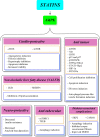Targeting AMPK by Statins: A Potential Therapeutic Approach
- PMID: 33939118
- PMCID: PMC8144155
- DOI: 10.1007/s40265-021-01510-4
Targeting AMPK by Statins: A Potential Therapeutic Approach
Abstract
Statins are a group of lipid-lowering drugs that inhibit cholesterol biosynthesis and have anti-inflammatory, anti-tumor, and immunomodulatory properties. Several lines of evidence indicate that statins regulate multiple proteins associated with the regulation of differing cellular pathways. The 5'-adenosine monophosphate-activated protein kinase (AMPK) pathway plays an important role in metabolism homeostasis with effects on cellular processes including apoptosis and the inflammatory responses through several pathways. Recently, it has been shown that statins can affect the AMPK pathway in differing physiological and pathological ways, resulting in anti-cancer, cardio-protective, neuro-protective, and anti-tubercular effects; additionally, they have therapeutic effects on non-alcoholic fatty liver disease and diabetes mellitus-associated complications. Statins activate AMPK as an energy sensor that inhibits cell proliferation and induces apoptosis in cancer cells, whilst exerting its cardio-protective effects through inhibition of inflammation and fibrosis, and promotion of angiogenesis. Furthermore, statin-associated AMPK activation leads to decreased lipid accumulation and decreased amyloid beta deposition in the liver and brain, respectively, and may have therapeutic effects on the liver and neurons. In this review, we summarize the results of studies of AMPK-associated therapeutic effects of statins in different pathological conditions.
Conflict of interest statement
Sajad Dehnavi, Amirhossein Kiani, Mahvash Sadeghi, Ali Farhadi Biregani, Maciej Banach, Stephen L. Atkin, Tannaz Jamialahmadi, and Amirhossein Sahebkar have no conflicts of interest that are directly relevant to the content of this article.
Figures

References
-
- Hardie DG. Sensing of energy and nutrients by AMP-activated protein kinase. Am J Clin Nutr. 2011;93(4):891S–S896. - PubMed
Publication types
MeSH terms
Substances
LinkOut - more resources
Full Text Sources
Other Literature Sources
Medical

